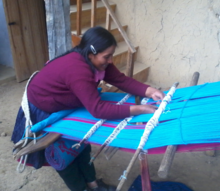Máxima Acuña
Máxima Acuña (born around 1970) is a Peruvian farmer from the Cajamarca area , who was known for her dispute over her land with the operators of the Yanacocha mine and was honored with the Goldman Environmental Prize in 2016 .
Life
Máxima Acuña lives with her husband Jaime Chaupe and their three children in a remote region in the northern highlands of Peru. The family cultivates subsistence (cf. Agriculture in Developing Countries ) a piece of land of 27 hectares at an altitude of 3,249 meters in Tragadero Grande ( Sorochuco District , Celendín Province , Cajamarca ), which the couple acquired in 1994. With her local expertise, Acuña weaves and sews clothes and uses the vegetation to dye fabrics. She sells these weaving products and grain in the market.
In 2011, Newmont Mining ( USA ) and Buenaventura (Peru), the operators of the nearby Yanacocha gold and copper mine, took over an area of 2,000 hectares in order to expand the mine with the Conga project with another open pit . The land that Acuña owns is also affected by the building plans. She refused to release her land for the Conga project because the planned open-cast mine would destroy four mountain lakes and contaminate and deplete the groundwater supplies in the high Andes of Cajamarca. The Yanacocha mine was responsible for a mercury accident back in 2000 that poisoned more than 1,200 villagers in the village of Choropampa in the Magdalena district .
The family thus became the target of eviction attempts, threats and intimidation by the Special Operations Division of the Peruvian National Police (DINOES). The first incident took place in May 2011. On August 9, 2011, the second, according to her information, she was visited by a group of mining engineers from the Yanacocha mine. These came accompanied by private security forces and the police. They invaded their property and tore down the fences and their house. Attempts to report the events to the police were ignored by them. Instead, the engineers came back in the summer, accompanied by a large contingent of police and soldiers and heavy mining equipment. They destroyed and confiscated all of their property, knocked her and her daughter unconscious, and held machine guns to her husband and son's heads.
The Peruvian police intervened against anti-mining protests on July 3, 2012. She opened fire in the crowd and shot 4 demonstrators. Dozens were injured. Immediately after this incident, President Ollanta Humala declared a state of emergency and restricted civil rights .
In October 2012, Acuña received support from 200 demonstrators, many of them accompanied by their children, who camped on the Acuña land to defend the mountain lakes. A few days later, on October 29, a court found her guilty of illegally occupying the land of the Yanacocha mine. The judgment was upheld by the appeal court in 2014. In February and September 2016, the mining company's security service broke into Acuña's property again, cleared their self-nourishing fields and justified this with legal self-defense in defense of their property.
The campesiños from the provinces of Cajamarca, Celendín and Hualgayoc who cracked down on the Conga project have repeatedly been the target of threats and violence. As a result, the Inter-American Commission on Human Rights (IACHR) of the Organization of American States (OAS) passed a resolution calling on the state of Peru to take measures to protect the Campesiños. Specifically, it called for their lives and their physical integrity to be ensured, for these measures to be coordinated with those affected and for the incidents of violence to be determined and reported to the commission.
On December 17, 2014, a court overturned Acuña's sentencing to three years in prison, including her expulsion from her country. Another result of this legal victory was that the Conga mine was kept out of the Tragadero Grande area. Acuña received the Goldman Environmental Protection Award on March 16, 2016 for standing up for her right to peacefully support her livelihood on her own land.
The acquittal of December 17, 2014 was upheld by the Supreme Court in 2017 and the proceedings against Acuña were finally dropped.
Web links
- The Goldman Environmental Prize, Máxima Acuña. 2016 Goldman Prize Recipient South and Central America , 2016.
- Mama Tierra, Máxima Acuña: the defender of the water, May 18th, 2014.
Individual evidence
- ↑ a b c 'Life yes, gold no!' November 21, 2012, accessed March 23, 2019 .
- ↑ Maxima Acuña-Atalaya v. Newmont Mining Corp. In: EarthRights International. Retrieved March 23, 2019 (American English).
- ↑ a b Peru - Máxima Acuña. Retrieved March 23, 2019 .
- ↑ Máxima Acuña. Retrieved March 23, 2019 (American English).
- ↑ Maxima Acuña de Chaupe: the defender of the water. Retrieved March 23, 2019 .
- ↑ Land, human rights, and international standards in the conflict between the Chaupe family and Minera Yanacocha. Retrieved March 22, 2019 .
- ^ OAS: OAS - Organization of American States: Democracy for peace, security, and development. August 1, 2009, accessed March 23, 2019 .
- ^ Máxima Acuña recibe el prestigioso Premio Ambiental Goldman. Retrieved March 22, 2019 .
- ↑ Máxima Acuña wins in court. Retrieved March 23, 2019 .
| personal data | |
|---|---|
| SURNAME | Acuña, Máxima |
| BRIEF DESCRIPTION | Peruvian activist |
| DATE OF BIRTH | around 1970 |
